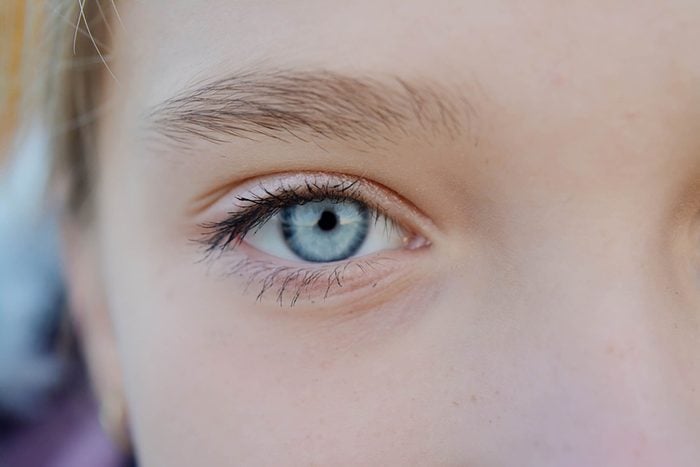If You Have Blue Eyes, You’re Related to a Lot More People Than You Thought
Updated: Feb. 09, 2023

Whether you're a brown-eyed girl or five-foot-two, eyes of blue, it's what's inside that counts. Seriously, we mean that: Your eye color has everything to do with your genetics, and if you're blue eyed, you can probably figure out who's a distant relative just by looking at them.
It could be said that all eyes are the same color. That’s because the pigment that gives our eyes color, melanin, is naturally brown. In fact, originally, “we all had brown eyes,” a professor from the University of Copenhagen, Hans Rudolf Litchoff Eiberg, PhD, told Science Daily. Somewhere along the way, however, someone was born with a genetic mutation, Dr. Eiberg explains. That genetic mutation limited the amount of melanin the person’s eyes could produce, with the visual effect being that the eyes appeared blue, rather than brown.
Interesting, you might be thinking, but what do blue eyes genetics have to do with me? Well, the fact that all (so-called!) blue eyes descend from a single genetic mutation means that every single person on the planet with blue eyes descended from one common ancestor. In fact, a team of geneticists at the University of Copenhagen actually traced that mutation all the way back to a single Danish family.
“By linkage analysis…we fine-mapped the blue-eye color,” Dr. Eiberg’s team reported in the journal, Human Genetics. Through that analysis, it was discovered that an identifiable group of genes had been inherited together from one single parent—the scientific word for a group of genes inherited together from a single parent is “haplotype.” The identified haplotype was common not just among 155 blue-eyed individuals from Denmark, but also five blue-eyed individuals from Turkey, and two blue-eyed individuals from Jordan. In addition to haplotype mapping, Dr. Eiberg’s team conducted mitochondrial DNA analysis, which looks at patterns of genetic mutation to trace maternal ancestry back hundreds of thousands of years.
“Variation in the color of the eyes from brown to green can all be explained by the amount of melanin in the iris, but blue-eyed individuals only have a small degree of variation in the amount of melanin in their eyes,” Dr. Eiberg notes. “From this we can conclude that all blue-eyed individuals are linked to the same ancestor…They have all inherited the same switch at exactly the same spot in their DNA.” Brown-eyed individuals, by contrast, have considerable individual variation in the area of their DNA that controls melanin production.
So, are blue eyes a mutation? Yes. But is that a good thing or a bad thing?
Neither, according to Dr. Eiberg. “It simply shows that nature is constantly shuffling the human genome, creating a genetic cocktail of human chromosomes and trying out different changes as it does so.” What we can presume, however, is that the color of our eyes is not the only thing trait that went along with the mutation that led to that color. For example, if you have blue eyes, you are far more likely to also have the following traits:
- higher melanoma risk
- more likely to be competitive
- lower vitiligo risk
To find out more about your own ancestry, you can try genetic testing. But be aware that you may not always be prepared for what you find out. Next, find out what is the rarest eye color in the world.
